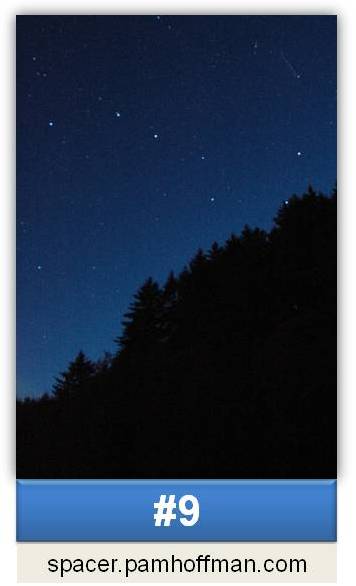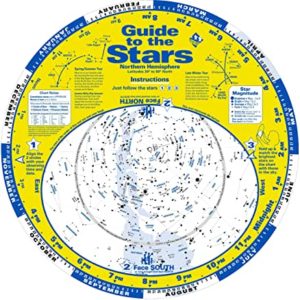 Perhaps you are not ready, willing or able to invest in spacer projects right now.
Perhaps you are not ready, willing or able to invest in spacer projects right now.
Would looking up at the stars and understanding constellations, finding planets, meteors, and such things be more your speed?
You could just go outside and look up. You’ll start seeing constellations right away. Even in the city you can see the brightest ones, or asterisms,* in spite of light pollution.
If conditions are right, you can see the moon and sometimes planets. You might even catch one or more meteors.
Remember too, you could even see satellites in the early evening or early morning.
Anything you see up there, you can look up online when you are back on your machine.
If you want to learn even faster, then you will need an important tool: A Planisphere.
This is probably one of the most basic tools you can use out in the field (the field being anywhere you can look up and see the stars) and you will learn a great deal from just this one compact tool. I think it should be part of anyone’s kit for stargazing.
A planisphere is “…a star chart analog computing instrument in the form of two adjustable disks that rotate on a common pivot. It can be adjusted to display the visible stars for any time and date. It is an instrument to assist in learning how to recognize stars and constellations.” Wikipedia
It shows you what you’ll see in the night sky when you set it for your date and time. It’s important to have one that coordinates with your latitude though, if it’s a little off, it may still be useful for much of the sky overhead.
Once you set your time and date, the constellations you see in the window should be the ones you see overhead. Be sure you get the directions (North, East, South and West) lined up with the names around the window. I tend to bring the planisphere above my head to help line everything up.
There is often additional information on commercial versions of the planisphere that will inform you of other great things in the night sky.
The moon, planets, meteors and satellites all move much faster in the sky than the stars do. I’ll go into a great tool for that soon – it’s that time of year after all!
BTW, I found a cool site with some PDF files you can print your own from recently. Check out Uncle Al’s Sky Wheels on the Ventura County Astronomical Society web site. There is some more information about using the planisphere there as well.
“Keep Looking Up” ~Jack Horkheimer
*An asterism is a pattern of stars. One such pattern is The Big Dipper which are the brightest stars in the Ursa Major constellation. Asterisms are found in one or more constellations.
NOTES:
*Newbie to pro
*Age: able to read
*Cost: commercial planisphere or the paper & ink to make a print out
sources
http://www.vcas.org/star-wheels.html
http://en.wikipedia.org/wiki/Planisphere
Photo: The Big Dipper shines above trees silhouetted by twilight about 1:30 a.m. Saturday, July 30, 2011 at Buskin River State Recreation Area on Kodiak Island, Alaska. http://www.flickr.com/photos/jkbrooks85/6000701167/







































Pingback: Check Out The Farmer’s Almanac! | Everyday Spacer
Pingback: Orionid Meteor Shower | Everyday Spacer
could it have been a meteor on Jan. 15th I saw??I live in Elba, NY. When ouidtse right around 9pm Eastern, looking in the sky I saw what looked similar to an airplane light except it was not white or yellow it was red and orange. It was moving however, so it got my attention (couldn’t have been just a planet.) It was moving North to South and then seemed to shift to West to East. I watched it for about 30-40 seconds. A plane was moving East to West and I was excited because I thought they would see whatever this was, and just then the red/orange light vanished. I moved my position, as I couldn’t believe this thing disappeared and then I saw a quick, pretty faint shooting star’ that went from East to West. Could this have been a meteorite entering our atmosphere? did anyone else see it? Thank you!